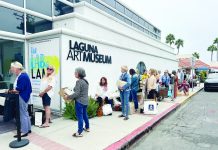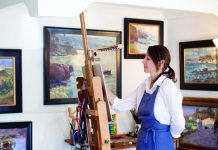
Sculptor Auguste Rodin is best known for his monumental works like “The Kiss,” “The Thinker,” or the historic “Burghers of Calais,” but Rodin aficionados know he also made compelling smaller pieces that are now components of museum and private collections.
It’s a welcome surprise then that the Laguna College of Art and Design will be the first Orange County venue to display 23 works by Rodin (13 figures and 10 lost wax process examples of his sculpture “Sorrow”) from July 11 to Sept. 23.
The coup comes courtesy of Ryan Fisher, an aspiring sculptor and Laguna Beach resident with a personal connection to a major Rodin collector.

“Rodin had students from all over the world and the school selected figures that this generation of LCAD students could relate to,” said Fisher, 36, who grew up surrounded by Rodins owned by his uncle and aunt, B. Gerald and Iris Cantor, who had homes in New York and Southern California.
Works are selected from a current 400-piece cache of Rodins held by the New York-based Cantor Foundation, which focuses on promoting the arts as well as medical research. The foundation has donated more than 500 pieces to museums including the Metropolitan Museum of Art in New York and the Los Angeles County Museum of Art. Altogether the Cantors collected roughly 750 Rodins.
“We have been loaning Rodins to college museum and galleries for three decades now. So far, 10 million people have seen the collection,” said Judith Sobol, the Cantor Foundation’s executive director.

The foundation underwrote Rodin exhibitions in the U.S., Canada, Australia and places in-between, underscoring a philosophy that art should be seen by the masses.
“We had put the program on hold to catch our breath when our newest trustee, Ryan Fisher, suggested the match with the Laguna College of Art and Design,” Sobol added.
The exhibition features two segments: “Figures,” consisting of 13 bronze figures ranging in height from 14 to 36 inches, and “Lost Wax Casting Process” comprised of 10 versions of “Sorrow” that illustrate the intricate casting technique. Finished figures include the iconic “St. John Preaching,” “Venus” and “Walking Man.”
“These two Rodin groups were selected to complement LCAD’s sculpture department and they are a rare opportunity for students, faculty and the public to interact with Rodin’s art for a couple of months,” Fisher said.

Fisher says his uncle fell in love with Rodin (1840-1917) in 1945 after seeing a marble version of Rodin’s “Hand of God.” “Eighteen months later, Bernie found the hand in bronze and paid the equivalent of two months rent, $200, to buy it,” recalled Fisher. “After buying the first piece, he began reading about Rodin extensively and became obsessed with him.”
After Cantor died in 1996, his aunt took up her husband’s mission but also expanded the foundation further to include medical research focused on women’s health care and research, said Fisher.
The Rodin exhibit’s journey to LCAD’s newly relocated gallery began a year ago. “Ryan was curious about a sculpture class and, touring the college, saw a figurative sculpture class in progress and told me afterward that this is the college that Rodin would want to attend were he alive today,” said Jonathan Burke, LCAD’s president.
“After making certain that the school met all the foundation’s requirements including security, we were able to look over loan groups that would make sense for our students and the public,” said Burke.

He wanted a summer show to take advantage of Laguna’s visitor influx and to make the school’s sculpture garden and program more visible to prospective students. “I want everyone possible to see work by the greatest sculptor since Michelangelo,” he said.
“Rodin liberated 19th century conventions: creating active surfaces that capture light while adhering to classical sculptural form he became a part of Impressionism. He is a prime example of artists being a product of their time. I hope everyone takes the time to see this world-class exhibition,” said Burke.
(www.cantorfoundation.org offers comprehensive information including a Rodin biography)




